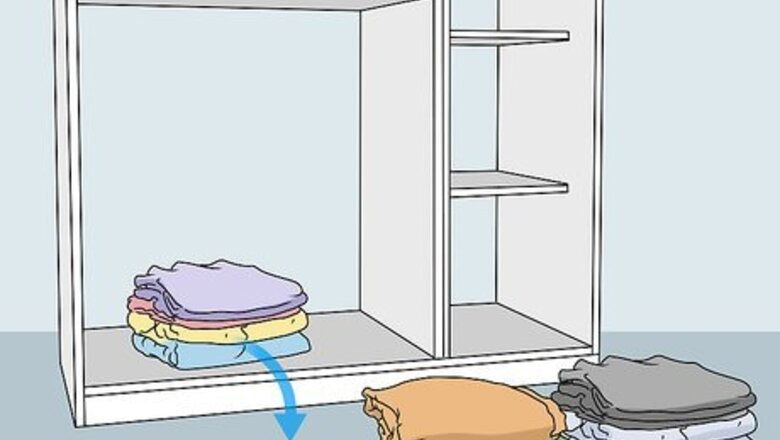
views
Cleaning out Your Wardrobe
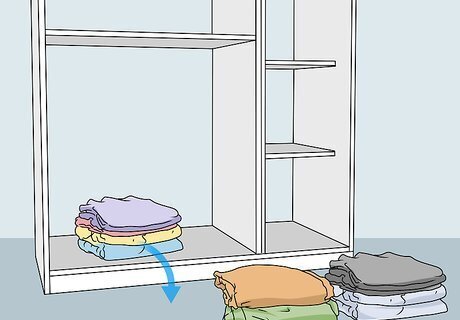
Remove everything from your closet and organize it into piles. Take out the items near the front first and set them aside. Then, pull out the items that have been pushed to the back of the closet over time. Place these in another pile so you have a snapshot of what you use most often and which items you may no longer need. You don’t have to get rid over everything you haven’t used in a while. However, it might be easier to decide what to discard if you know which items don’t get used often.Tip: You may want to sort your closet by section so you don’t become overwhelmed.
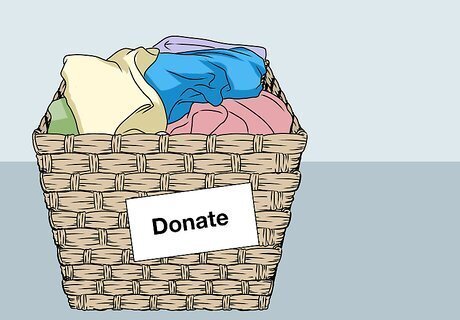
Scan the items you don’t use often to identify things you don’t want. Before you go through your entire wardrobe, do a quick pass over the items from the back of your closet. Remove any items you know you don’t need and place them in your donate or discard piles. Merge any items that remain with the rest of your wardrobe. This can save you a lot of time and energy during the sorting process. Don’t pick through the items during this phase. Just remove items you don’t have to think about.
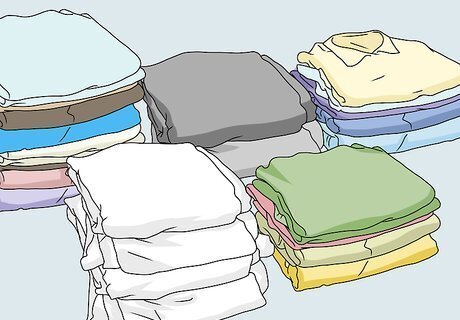
Group like items together so you can see what you have. Like most people, you probably have duplicates of certain items. Sort your clothing and accessories into piles of like items. Separate the piles so you can go through them one-by-one. For instance, you might make piles for T-shirts, sweaters, jeans, trousers, skirts, dresses, leggings, workout clothes, and outerwear.
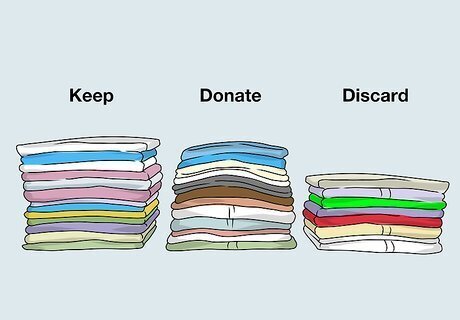
Sort items into piles for what you'll keep, donate, and discard. Sort through your items before you place them back in your wardrobe. Start by removing duplicate items that you don’t need since that may be an easier decision. Then, identify which items you still plan to wear and what you can let go of. Place each item in the correct pile to keep it, donate it, or discard it. Don't worry about keeping the items sorted into categories. You may decide to keep everything, and that’s okay. Donate the items you no longer want or use to a local charity, thrift shop, friend, or family member. Throw out any items that are worn or damaged.
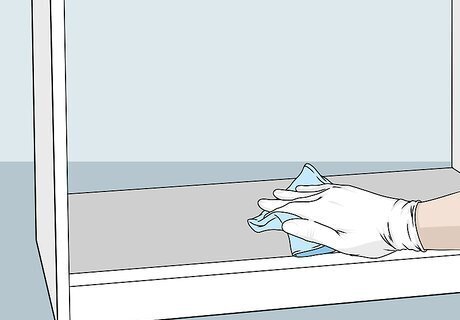
Clean the walls, shelves, and floor of your closet or armoire. Wipe down the shelves with a dust cloth. Then, use your cloth to wipe any dust or debris off of the walls. Afterwards, sweep or vacuum the floor, if applicable. If your shelves are very dusty, you may want to switch dust cloths before you wipe down the walls.
Creating an Organizational System
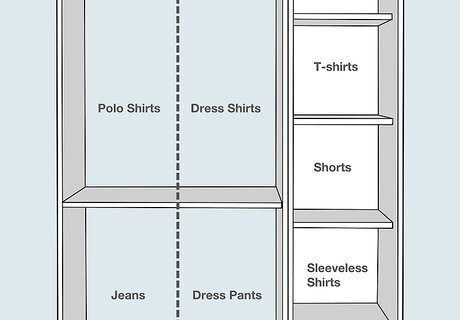
Divide your closet into zones so you know where everything goes. Examine the space you have in your wardrobe and decide where you want each type of item to go. Pick a place for tops, sweaters, pants, skirts or dresses, outerwear, shoes, and accessories. Allocate space based on how much you have of an item. This way you can make the best use of the available space and store clothes more efficiently. For instance, if you wear a lot of T-shirts but only have 2 sweaters, you might designate a large area for T-shirts. Similarly, you could designate separate bins for sweaters, button-up shirts, T-shirts, pants, skirts, and dresses. You might decide to put hooks on the wall for your coat, belts, and ties.
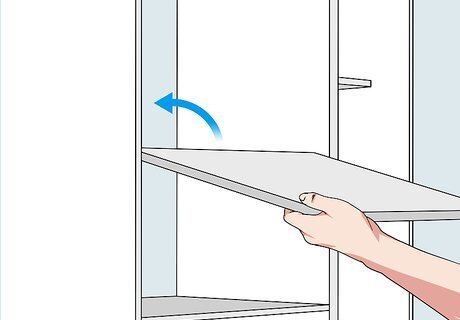
Install more shelving or drawers in your closet if you need it. When you’re not using hangers, shelves and drawers become essential for storing your clothes. Fortunately, many closets and armoires already have shelving or drawers. If yours doesn’t, add additional storage space. Try the following: Add a shelving unit to your closet. Hang floating shelves in your closet or armoire. Put a bookcase in your closet for more shelving. Place a dresser or plastic drawers in your closet. Hang hooks and baskets against the wall.
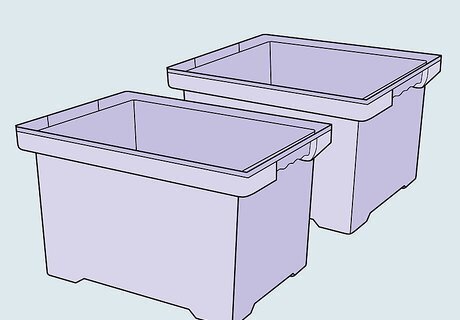
Use boxes or bins to organize clothing. Although you can stack your clothes on shelves, you might prefer to use boxes or bins to group like items. Not only will this keep your closet organized, it also makes your wardrobe look nice. Pick baskets, bins, or cloth containers that fit your style aesthetic. Arrange them on your wardrobe shelves. Decorate plain boxes for a fun, budget-friendly option. Consider using color-coded bins and boxes for different items. As an example, you might put your T-shirts in a grey bin, your pants in a grey-and-white striped bin, and your dress shirts in a white bin. Bins and boxes are a great place to store out-of-season items, such as your coat and sweaters.
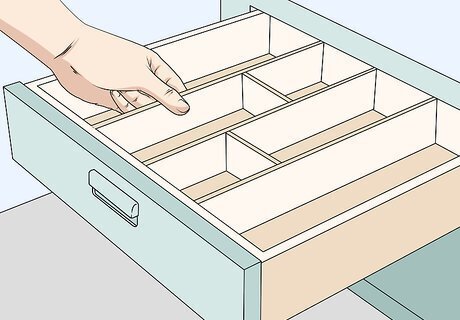
Put dividers in drawers or trays to separate small items and accessories. It’s easy for small items to get mixed together in your drawers or storage trays, which can be super annoying. Additionally, it’s hard to see what you have if it’s all mixed up. To keep your items organized, insert dividers into any drawers or trays where you’re planning to store small items. For instance, use dividers to separate socks, hosiery, jewelry, ties, and belts.
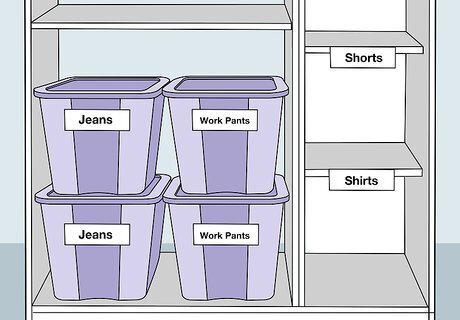
Label your containers or shelves so everything is easy to find. One of the drawbacks of not using hangers is that you won’t be able to easily scan your wardrobe contents. Instead of flipping through hangers, you’ll need to examine stacks or pull out bins. To make things easier, put labels on boxes, baskets, or bins and consider labeling your shelves. As an example, you might separate your T-shirts into a workout pile and a going out pile. Use a label to keep track. If you’re using bins, you might label them things like “work pants,” “jeans,” and “sweaters.” If you used color-coded bins, you may not worry about labels.
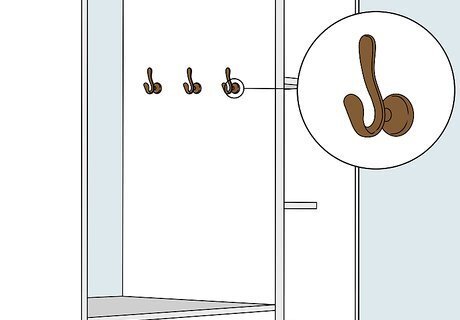
Install hooks on the walls of your wardrobe to hold accessories. Hooks are a great addition to your wardrobe because they can hold items like scarves, ties, belts, handbags, and jewelry. You might also use hooks to hold items you wear often, like your favorite jacket. Install wall hooks in your wardrobe if you want a permanent option. If you prefer temporary hooks, try something like command hooks, which come in different shapes and sizes. You can also just hammer nails into the wall to use as hooks.
Arranging Items in Your Wardrobe
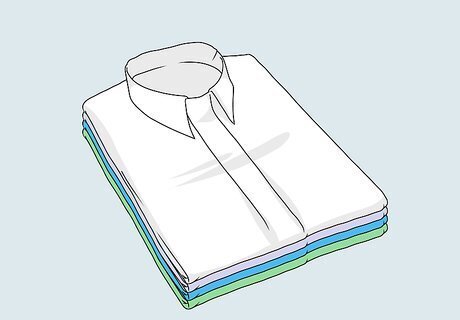
Fold your items so they're a uniform shape and size. Check the space you have to store each type of clothing before you start folding. Then, fold each item so it's small enough to fit in your allotted space. Try to fold each item into the same sized square so they're easier to stack. Use the first item you fold as a guide for the rest. Keep in mind that your stacks may lean or fall over if some items are folded smaller than others.
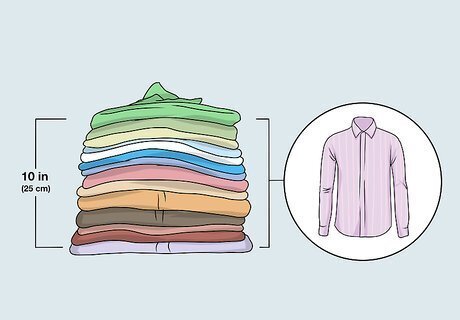
Stack your clothes according to category and style. Make different stacks for each type of clothing. Additionally, consider separating items you have several of by style so it's easier to grab what you need. Limit stacks to 10 in (25 cm) high, as taller stacks may tumble over. For example, you may have a stack of T-shirts, a stack of dress shirts, a stack of work pants, a stack of jeans, and a stack of dresses. If you decide to separate your clothes by style, you might divide your pants into straight-leg pants, wide-leg pants, and boot-cut pants.
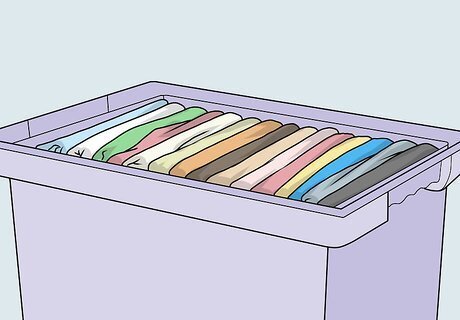
File your clothes in drawers or bins rather than stacking them. When you stack your clothing, it’s really hard to see what you have. Instead, store each item of clothing vertically like in a file cabinet. This allows you to see every item of clothing by just scanning the top of your drawers or storage containers. For instance, let’s say you’re using cloth bins to organize your shirts. Fold your T-shirts into a uniform size. Then, turn them so that the folded edge is facing up before placing the shirts into the container.Alternative: Roll up items of clothing instead of folding them.

Put items you wear most often within easy reach. It'll be easier for you to find what you need if your favorite clothes and accessories are right in the front. Generally, the center of your closet is the easiest spot to access, so it’s the best place to store the things you wear on a daily basis. For example, you might arrange your work clothes at eye level.
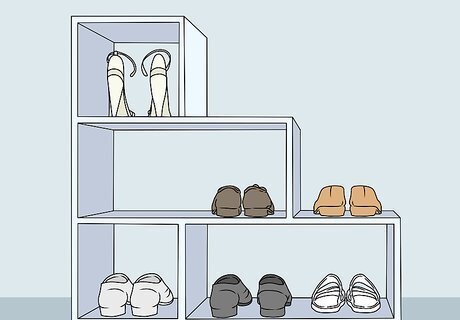
Place shoes on a shoe rack or line them up on the floor. You’re more likely to wear items you can see, so don’t leave shoes in their boxes. Instead, stack them neatly on a shoe rack to save space while keeping your shoes front and center. If you don’t have a shoe rack, simply line up your shoes in rows. If you prefer to have your shoes in boxes, place them in clear plastic shoe storage containers. Put a photo of the shoe on the end of the box that faces out so you know which shoe is in each box.
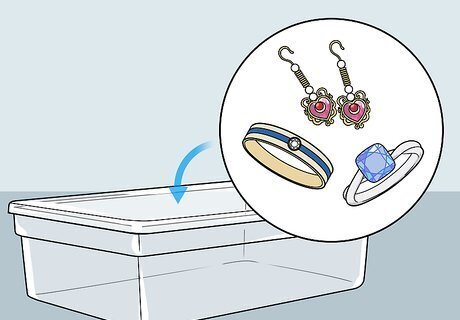
Store your accessories in small containers if you can't use hooks. Accessories like jewelry, scarves, ties, belts, and purses can be difficult to organize. The easiest way to keep them sorted is to put them into a small box or drawer. Arrange your accessories so it’s easy to see what you have when you open the container. If you don’t have a small container and don’t want to buy one, an old shoe box works well. If you’re using dividers, it’ll be easier for you to keep the items separated.
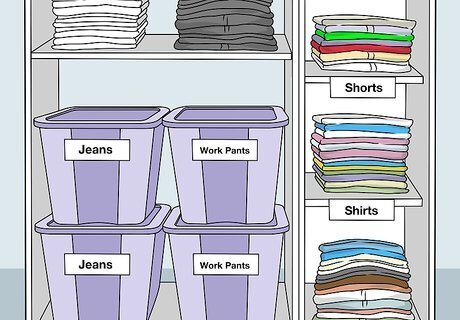
Finished.















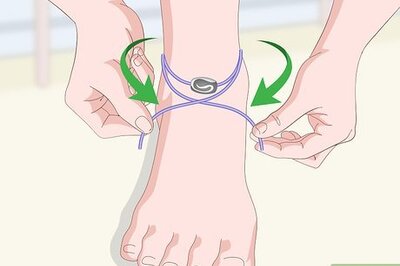


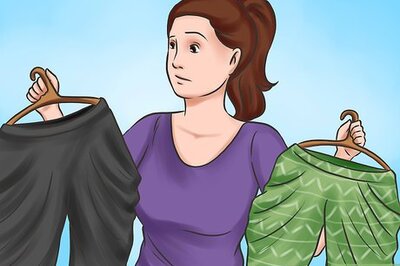
Comments
0 comment